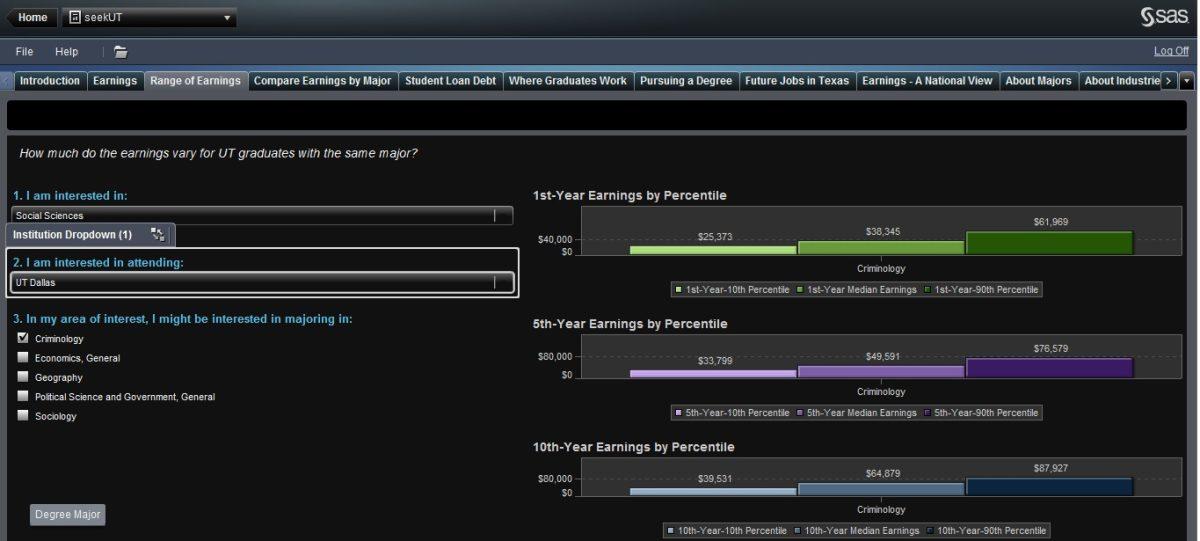As of last week, current and incoming students at the undergraduate and graduate levels across Texas can use seekUT, a new website that shows expected salaries out of college and expected student loan debt.
UT System Chancellor Francisco Cigarroa created the Student Debt Reduction Task Force to study the problem of student debt and its impact on students and their families.
The seekUT website was formed out of the task force’s recommendation that UT System provide students and parents with information that would help them decide on a college, said Stephanie Huie, vice chancellor of the Office of Strategic Initiatives at the UT System, or OSI.
This is the first website of its kind in the nation, she said.
“Even if I’m not going to UT System schools, say I’m going to Baylor or Rice, I can still find out generally what my income is going to be by my major at the 10th percentile (or) 90th percentile one, five or 10 years out,” said Student Government Vice President Nancy Fairbank. “I can see predicted job growth in my major and my area of interest in Texas as a whole and also by region in Texas. It’s just a new and interesting way to look at data and help students make smart decisions.”
The website shifts the conversation to how much students actually make after graduation instead of outcomes defined by graduation and retention rates to how much students actually make after graduation, Huie said.
“There has been an emphasis on the first year out,” said OSI Director David Troutman. “As we all know your first job out of college is really your lowest paid job, and we felt it was really important to follow students over time and not only report first year but fifth year and 10th year, and that’s why (we) provide those ratios of incomes at the end of fifth year and 10th year.”
Huie and her team were able to negotiate a contract with the Texas Workforce Commission to gain access to wages and workplace information for students who are currently enrolled in a UT System school or graduated out of one of these schools, as long as they are still in Texas, he said.
The seekUT team toured different UT System campuses, including UTD, UT Austin, UT Arlington and UT San Antonio. Students at these campuses were able to use the online tool and provide feedback on improvements after the website’s soft launch with only undergraduate data in January 2014, Troutman said.
Fairbank was one of the students who attended the presentation at UTD. Later, she and SG President Brooke Knudtson attended the UT Student Advisory Council meeting in Austin where student government representatives from all UT System schools provided feedback on the website.
The new version of seekUT was released the second week of October just before the website was to be presented to leaders in Washington D.C., Huie said. Troutman and Huie chose Fairbank to represent the student perspective on seekUT in D.C.
Fairbank, Huie and Troutman met with several senators, representatives and reporters from Politico to talk about seekUT.
The team’s primary purpose was to show politicians in what could be done with such extensive data that some university systems have but don’t know how to use, Huie said.
The other objective discussed in these meetings was the possibility of national-level data from federal agencies that would allow seekUT to include wage information of alumni working outside Texas, she said.
While there is a possibility for such data to be made available to OSI, there is an ongoing controversy about making such data available to federal institutions and making student data susceptible to attacks, Huie said.
There also has been a push for the federal government to acquire student-wage and debt data from across the nation to develop a ranking system using the information, she said.
While this data could be used toward developing such a ranking system, Fairbank said she worries that doing so will take the power of inference away from students.
“If you rank schools, you take out all kinds of user interpretations,” she said. “More importantly, I think almost no student that I know reads the methodologies behind the rankings, so they don’t understand what the important factors are that are being weighed and maybe those factors aren’t important to them.”
As of now seekUT will not be used for a ranking purpose, Huie said.
“We’re providing unbiased information with no judgments so that students can make their own decisions,” she said.
Meanwhile, UT System has partnered up with the Texas School Counselor Association to inform guidance counselors in high school is about how to use seekUT to help students decide the university and major they want to choose should they decide to stay in Texas, Huie said.
The seekUT team will also conduct system tours where a team will visit different UT System schools and pair up with the career advising centers, financial aid and admission offices to help promote the tool, Troutman said.
OSI also is using the data to spearhead several research projects in different UT schools, he said.
One such project at UTSA involves analyzing the correlation between on- and off-campus jobs held by current students and their impact on the students’ GPA and likelihood to graduate on time, Troutman said. The findings of the research will be used to recommend policies to schools on providing more on-campus jobs to students to help increase four- and six-year graduation rates, he said.
The project is constantly being evaluated and will continue to evolve as student needs change, Troutman said.











